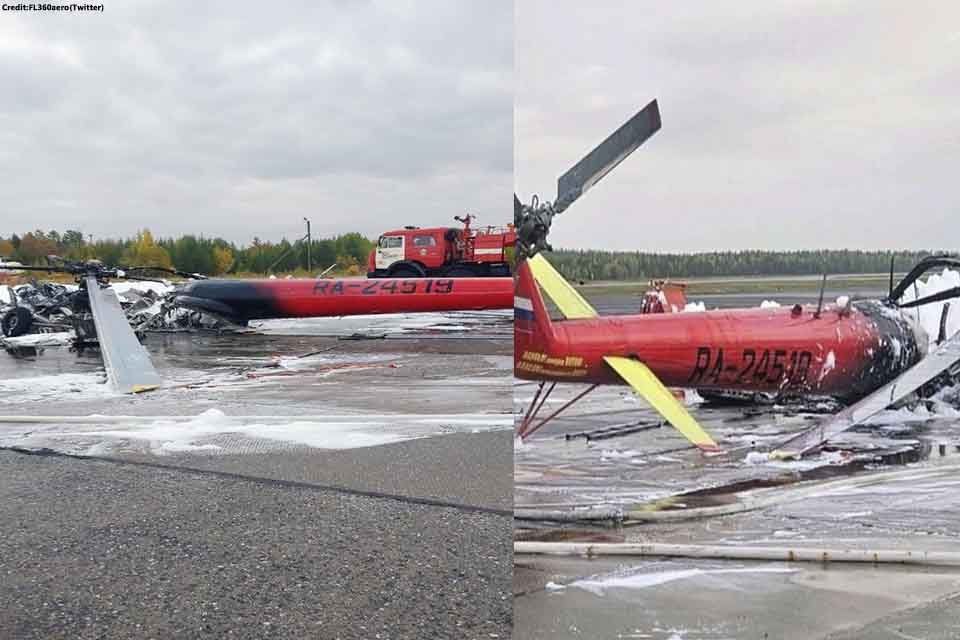Aviation
Two Russian Schoolboys Arrested for Destroying Mi-8T Helicopter

In a shocking act of sabotage, two Russian teenagers, aged 13 and 14, have been arrested for burning down a Mi-8T military helicopter at an airport.
The boys, Timur and Sasha, reportedly used flammable liquid and cigarettes to ignite the helicopter, resulting in a fiery explosion that caused severe damage, leaving the aircraft almost completely destroyed.
A Costly Mistake: Passenger Pays for Fuel After Disruptive Flight
According to reports by Russian media outlet BAZA, which has close ties to law enforcement, the teenagers claimed they were promised around £42,000 through the Telegram messaging app in exchange for carrying out the attack.
While the source of the offer remains unknown, one theory suggests the boys may have been motivated by the hope that the act could somehow help bring home the father of one of the teenagers, who had been conscripted to fight in the war in Ukraine.
Egypt has signed an agreement with China to purchase J-10C fighter jets
The destruction of the £1 million helicopter led to their immediate arrest, as the boys suffered significant facial and hand burns during the incident. After fleeing the scene, they sought medical assistance, which ultimately revealed their involvement in the attack. Both teenagers are now under armed guard while receiving treatment in a local hospital.
Authorities revealed that this was not the first act of sabotage carried out by the boys. Earlier, they confessed to being paid £250 to destroy a mobile phone mast, which they successfully completed before targeting the helicopter. During their interrogation, they admitted to receiving 30,000 rubles for setting fire to the cell tower and were promised 5 million rubles for the helicopter attack.
The Mi-8T helicopter, used for military purposes, was reportedly left “almost completely wrecked,” with only the tail remaining intact following the explosion.

Aviation
China Eastern Receives Its Ninth C919 Aircraft, Marking a New Milestone

China Eastern Airlines (CEA) has reached a significant milestone with the delivery of its ninth COMAC C919 aircraft, continuing its lead as the launch customer for China’s domestic narrow-body airliner.
On Thursday, the airline received the latest addition to its fleet, registered as B-657T, marking another step in China’s ambitious efforts to establish itself as a key player in the global aerospace market.
Virgin Australia Launches Black Friday Sale on Flights Worldwide
This delivery is part of a major achievement for COMAC (Commercial Aircraft Corporation of China), which has now delivered a total of 10 comac c919 in 2024 alone, a remarkable increase from just three jets delivered by the end of 2023.
The C919 program represents China’s entry into the competitive market for commercial aircraft, aiming to rival the dominance of manufacturers like Airbus and Boeing in the narrow-body sector.
These 6 Airlines Are Giving You Free Wi-Fi on Your 2025 Flights
One standout feature of the c919 is its innovative in-flight technology, particularly its Wi-Fi system. Developed by the China Electronics Technology Group Corporation (CETC), this system allows passengers to connect to the “CEAIR-WIFI” wireless hotspot, providing seamless access to in-flight entertainment.
Through the website www.muflyer.com, travelers can enjoy a range of features including “Air Cinema” and “Air Games,” which enhance the flying experience.
Looking ahead, COMAC’s ambitions are not limited to narrow-body aircraft. At the 15th China International Aviation and Aerospace Exhibition in Zhuhai, c919 aircraft price made waves with the announcement of over 100 new aircraft orders.
A significant highlight was a high-profile agreement with Air China for the development of the C929, a widebody aircraft set to compete c919 vs a320 and c919 vs 737 with these models.
-

 Aviation2 months ago
Aviation2 months agoMicrosoft Flight Simulator Raises $3 Million to Bring Back the An-225 Mriya
-

 Airlines2 months ago
Airlines2 months agoQatar Citizens Can Travel to the United States Without a Visa
-

 Aviation2 months ago
Aviation2 months agoQatar Airways bans these new Electronic Devices on plane
-

 Defence2 months ago
Defence2 months agoWhich Country Has the Largest Fleet of Fighter Aircraft?
-

 Airlines1 week ago
Airlines1 week agoDAMAC Air: Dubai’s New Luxury Airline Offers Free Flights for Registration
-

 Airport2 months ago
Airport2 months agoWestern Sydney Airport Welcomes Its First Plane After 6 Years of construction
-

 Airlines7 days ago
Airlines7 days agoAir India to Launch aircraft maintenance training institute in Bengaluru
-

 Aviation2 months ago
Aviation2 months agoDid you know ? Once Boeing 747 carried 1088 passenger in 1991








